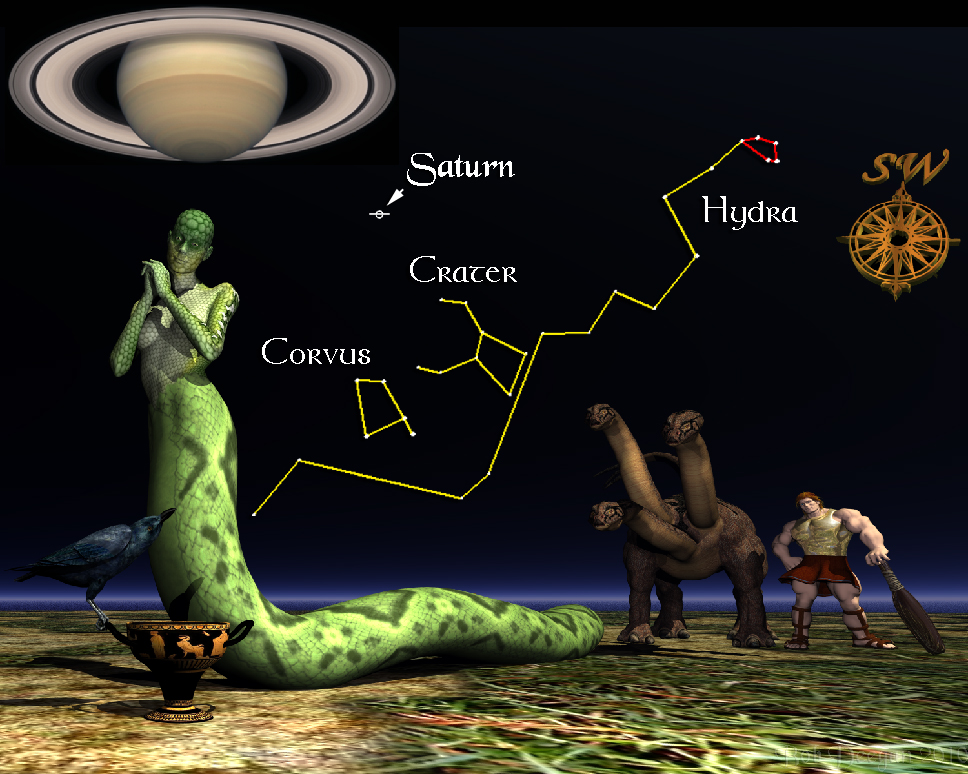
For the week including April 29, 2011

THE WATER SNAKE
Over the centuries, certain areas of the sky became associated with particular stories in mythology and some of the legendary animals depicted among the stars have appeared on astronomer’s maps for thousands of years. Of these classical constellations, none extends along a greater tract of sky than Hydra, the Water Snake. Hydra stretches out over one-third of the evening sky, and as the ages have passed, many companion constellations have been tacked onto its length. After sunset, a good way to find this southern constellation is to look for the group of brighter stars that mark the Snake’s head. Like some of the other very oldest star groupings, nobody seems to know exactly where this constellation came from.
Most historians of the stars associate the Hydra with various Greek legends. Jason’s quest for the Golden Fleece, involved a treasure that was guarded by a fierce nine-headed dragon called the Hydra, but probably the most famous story about the Hydra involves Hercules, the greatest hero of Greek mythology. During an especially low period in his life, Hercules became obligated to a hostile king named Eurystheus who challenged him to perform twelve impossible feats. One of these labors was to slay the Hydra living in the swamps of Lerna. This nasty beast devoured sheep, cattle, and the occasional people that crossed its path. At first, Hercules wondered why the inhabitants of Lerna hadn’t gotten rid of the Hydra themselves, but battling it provided an answer. Whenever Hercules clubbed away one of the Hydra’s many heads, another would grow to replace it. Their combat lasted into the night and Hercules finally defeated the monster by using a torch to sear closed the Hydra’s wounds so that its heads couldn’t grow back.
The stories of Jason and Hercules have always been crowd pleasers, but a problem with choosing among these tales is that the constellation of Hydra pre-dates the Greek culture they come from and a quick look at our star chart shows that this Hydra has only one head.
A clue may be found in older legends from Mesopotamia and Babylon that tell of enchanted snake-people inhabiting various rivers and marshlands and it’s these myths that may have made their way into the stars. The female water snake (Hydra) can be seen from the northern hemisphere while the male is visible from the southern hemisphere as the constellation, Hydrus.
The other constellations in our illustration, Corvus, the Crow, and Crater, the Cup, come from another story from yet another Greek myth. It seems that Apollo, the Sun god, was driving his Sun-chariot high across the skies one day and that he had developed an annoying thirst. Since there were no convenience stores or fast food restaurants at that altitude, he gave a cup to a passing crow and ordered the bird to bring it back filled with water. The crow accomplished the task after first defeating a tremendous snake that attempted to steal Apollo’s cup. Today, we have the nearby constellations of Corvus and Crater to commemorate the tale.
Above the Crow and Cup, Saturn shines with a distinctive yellow glint. The most distant planet you can see with the naked eye, Saturn is brighter than the stars in that region and a good set of binoculars are all you’ll need to pick out its famous ring system.
Fun Saturn fact for the Day: Saturn is mostly made up of hydrogen and helium which helps make it the least dense of all the planets. In fact, if you were to take a fairly good-sized bucket of water and drop Saturn into it, the planet would float! (Don’t try this at home.)
Unless otherwise indicated, all content of this web site is the copyright of Robert Deegan and all rights are reserved.
For more information, or to comment, please contact: Bob@NightSkies.org